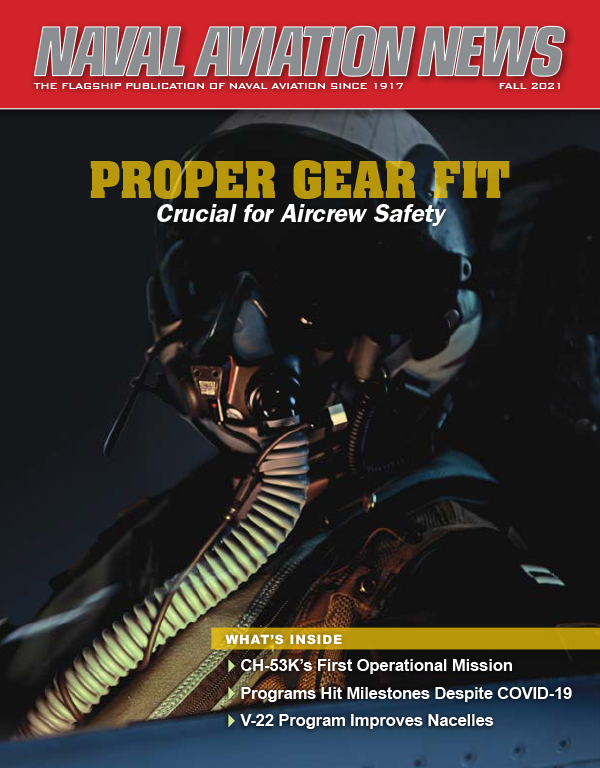
As part of our continuing coverage of the Navy’s No. 1 safety priority, this edition features an update on mask fitting protocols for jet pilots and how a proper fitting mask can prevent physiological episodes from occurring on page 28. On page 26, the “Air Wing of the Future” deployed with USS Carl Vinson (CVN 70) joined allies from the U.K. and Japan in a training exercise to demonstrate our continuing relationships with partner nations while highlighting the Navy’s newest warfighting capabilities. Many acquisition programs have adapted to complete their mission during the COVID-19 pandemic, and we highlight a couple of success stories on page 38. On page 40, learn about research efforts at the Naval Air Warfare Center Weapons Division where scientists are collaborating with many partners to take bacteria and develop it into cleaner burning and more efficient jet fuel.
>>READ MORE>>
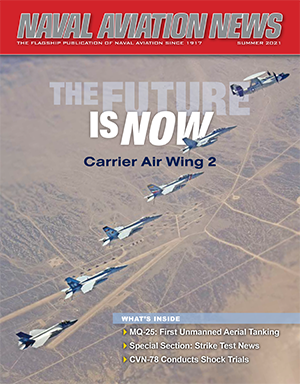
In this edition we celebrate recent Naval Aviation milestones, starting on page 22 with the conducting of Full Ship Shock Trials of first-in-class USS Gerald R. Ford (CVN 78), putting the aircraft carrier one step closer to operational deployment. On page 32, we highlight how the Hornet Health Assessment and Readiness Tool (HhART) has directly contributed to the decline in physiological episodes (PEs) in pilots. In the Marine Corps, aviators are taking cues from online gaming concepts to train for flight, page 36. As we have featured in summers past, we host a special section from Air Test and Evaluation Squadron (VX) 23 on page 47, where members of the squadron share the latest updates on emerging technology being tested prior to fleet delivery; we also introduce the squadron’s new commander, Capt. Elizabeth Somerville, the first woman to take command of VX-23 on page 44.
>>READ MORE>>
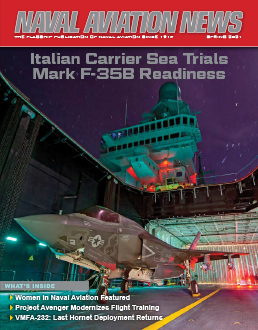
In celebration of Women’s History Month, we feature a special section beginning on page 30 highlighting recent achievements by women in the field of Naval Aviation, as well as recognizing a few of the many pioneers who broke through barriers to make their mark not only in the skies, but in the march toward equality and human innovation. Despite many challenges caused by the COVID-19 global pandemic, the Navy continues to develop evolving technology and innovative ways to prepare the next generation of warfighters. On page 28, the first Project Avenger flight training class completed its streamlined syllabus with the aid of virtual reality, while engineers and maintainers are using similar technology to perform repairs around the world on page 40. Catch a glimpse of the future of at-sea resupply with the first test of an unmanned aircraft system delivery from shore to USS Gerald R. Ford (CVN 78) on page 20. >>READ MORE>>
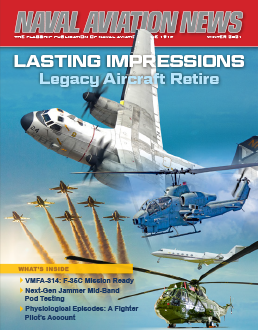
As technology continues to evolve, this edition features fond farewells to several naval aircraft nearing the end of their service life and highlights new technologies. Naval Aviation continues evolving with the Marine Fighter Attack Squadron (VMFA) 314 declaration of Initial Operational Capability for the F-35C Lightning II on page 38, and testing of the Next-Generation Jammer Mid-Band pod on the EA18G Growler on page 30. And we continue our coverage of physiological episodes with an article on rehabilitating naval aviators who suffer from pressure-related events and a first-hand account from a former F/A-18 pilot on their experience and recovery starting on page 40.
>>READ MORE>>
2020
In this edition of Naval Aviation News, we highlight several technological advances and upgrades to existing aircraft and carriers despite the ongoing challenges presented to our fleet due to the COVID-19 pandemic. On page 24, USS Gerald R. Ford (CVN 78) marked its 4,000th catapult launch/arrested landing and welcomed its dedicated air wing while undergoing its latest steam trial in the Atlantic Ocean. In our continuing coverage of the U.S. Navy’s investigation into and prevention of physiological episodes, we highlight the latest changes to the Naval Aviation operating instruction on page 40. And on page 44, the CH-53K King Stallion was put through sea paces with the assistance of the Air Test and Evaluation Squadron (HX) 21 and the crew of USS Wasp (LHD 1).
>>READ MORE>>
Our first 60-page issue includes several personnel, command and acquisition milestones. Medical team members of the Physiological Episodes Action Team share their increased understanding of the physical challenges experienced by aircrew in one of the harshest work environments and how to mitigate them, starting on page 25. On page 20, USS Gerald R. Ford (CVN 78) and her crew continue testing and trials to prepare the ship for deployment. In the second installment of Strike Test News, Air Test & Evaluation Squadron (VX) 23 updates the fleet on major flight test programs on page 49.
>>READ MORE>>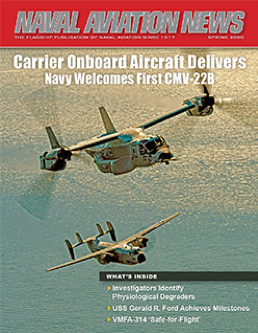
This issue highlights several beginnings and endings for Naval Aviation. The CMV-22B arrived at Naval Air Station Patuxent River, Maryland, to begin developmental and operational flight test and conducted a farewell flight with Air Test and Evaluation Squadron (VX) 20’s C-2A Greyhound in March, page 26. Rear Adm. Fredrick Luchtman, Commander, Naval Safety Center, discusses the conclusions reached by the Physiological Episodes Action Team and the importance of physiological margins, equipment fit and aircraft mitigations for aviators starting on page 12. Recent operational milestones achieved by USS Gerald R. Ford (CVN) 78 and her crew begin on page 18.
>>READ MORE>>
This issue highlights the updated capabilities of the E-2D Advanced Hawkeye starting on page 26. Vice Adm. Dean Peters, commander, Naval Air Systems Command, and Bill Taylor, assistant deputy commandant for aviation, share the ongoing benefits Naval Aviation is reaping under the Naval Sustainment System-Aviation initiative on page 4. The latest on deployed and Ford-class aircraft carriers is featured throughout the magazine with a summary of the recent USS Abraham Lincoln (CVN 72) deployment on page 8. Page 14 discusses aircraft compatibility testing aboard USS Gerald R. Ford (CVN 78) and page 16 covers advanced arresting gear operations. The christening of PCU John F. Kennedy (CVN 79) and the naming of USS Doris Miller (CVN 81) follow. Our coverage of Naval Test Wing Atlantic squadrons continues with an update on test projects conducted by Air Test and Evaluation Squadron (VX) 20 on page 35.
>>READ MORE>>
2019
This issue contains updates on a range of platforms starting with the F/A-18E/F Super Hornet and EA-18G Growler communities, which have implemented changes that will ensure Naval Aviation continues to sustain its 80-percent mission-capable rate of F/A-18E/F Super Hornets and EA-18G Growlers. Other milestones include the first flight of the first operational carrier-based unmanned refueling aircraft, the MQ-25 Stingray and the first E-2D with aerial refueling capability joins the fleet. Commander, Joint Strike Fighter Wing looks back on its first year and the MH-60S community receives the first two redesigned gunner seats. Naval Test Wing Atlantic (NTWL) continues to promote its mission—testing Naval Aviation’s latest technology for the fleet—with a question-and-answer piece from Commodore Col. Rich “Chachi” Marigliano, and a special section on the testing conducted by Air Test and Evaluation Squadron (HX) 21.
>>READ MORE>>

In this issue, VX-23 updates the fleet on flight tests performed during 2019 in a special section starting on page 39. On page 4, Cmdr. Glenn Rioux, U.S. Naval Test Pilot School Commanding Officer, outlines what it takes to qualify for test pilot school. The Naval Aviation Enterprise continues to focus on readiness with the implementation of the Military Depot-Level Certification program and its first certified Sailor, Aviation Mechanic 1st Class Michael Hammer at NAS Lemoore (page 16). The Naval Air System Command’s additive manufacturing team continues to deliver affordable parts to the fleet in record time (page 32).
>>READ MORE>>
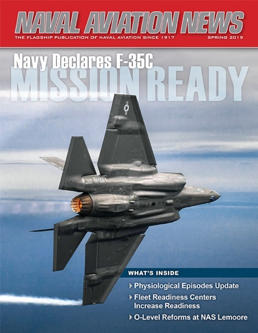
The F-35C Lightning II graces our cover again this issue after achieving initial operating capability Feb. 18. Strike Fighter Squadron (VFA) 147 shares how they transitioned from the F/A-18 Super Hornet to the F-35C. Most of this issue focuses on readiness reforms implemented as part of the Naval Sustainment System initiative. We follow the progress made at Fleet Readiness Centers and the operational-level reforms at Naval Air Station Lemoore, California.
>>READ MORE>>
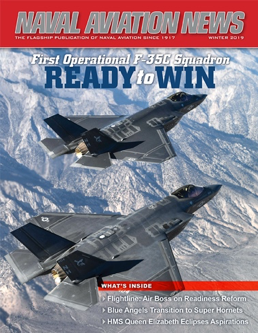
Readiness is the focus of this issue. The first F-35C Lightning II squadron, the “Argonauts” of Strike Fighter Squadron (VFA) 147, has obtained their safe-for-flight certification and the Navy expects to declare initial operating capability later in February, page 18. In Flightline, page 4, Vice Adm. Dewolfe Miller, commander, Naval Air Forces, elaborates on Naval Aviation’s initiates that take advantage of every opportunity to accelerate, improve and sustain readiness recovery. Several articles highlight recent readiness accomplishments such as the improvements at the Hydraulics Shop at Fleet Readiness Center Southwest, page 31, and the contributions Navy Reserve Sailors are making at FRCs across the country. >>READ MORE>>
2018
This Fall issue celebrates several recent milestones achieved by the F-35 Lightning II from sea trials aboard the HMS Queen Elizabeth (page 26) to the Marine Corps’ first F-35B combat strikes (page 9). During operational testing with Carrier Air Wing (CVW) 7 aboard aircraft carrier USS Abraham Lincoln (CVN 72), F-35C stealth fighters were integrated into the air wing for the first time (page 10); and the Navy’s new carrier-on-board-delivery aircraft, the CMV-22B Osprey, is on track to deploy with the F-35C (page 18).
>>READ MORE>>
It’s been a busy summer in Naval Aviation. In May, aircrew from the HMS Queen Elizabeth, flagship of the Royal Navy’s new class of aircraft carriers, visited Naval Air Station Patuxent River, Maryland, for their first live glimpse of the F-35B Lightning II (page 24), and a prototype of a new gunner seat for the MH-60S Seahawk debuted to great enthusiasm at the Naval Helicopter Association Symposium (page 28). On May 31, Naval Air Systems Command welcomed its new commander, Vice. Adm. Dean Peters, and he outlines his priorities for us in this issue’s Flightline on page 4.
>>READ MORE>>
This Spring issue is full of F-35 Lightning II success stories—from completing testing for the System Development and Demonstration phase April 11 (page 8) to the F-35B deploying with Marines on USS Wasp (LHD 1) in March (page 9) to the first flight, also in March, of Marine Fighter Attack Squadron (VMFA) 122 (page 10). Also featured is F-35B test pilot Maj. Robert Guyette, who received the Marine Corps Aviation Association’s John Glenn Squadron 2018 Test Pilot Award, in part for his team’s redesign of the F-35’s night vision system and its subsequent test and evaluation (page 30). >>READ MORE>>
The new year began with Vice Adm. DeWolfe H. Miller III relieving Vice Adm. Mike Shoemaker as Commander, Naval Air Forces (CNAF) Jan. 11. As the eighth Air Boss, Miller’s top three priorities are warfighting, people and readiness. Read more about Miller’s focus and goals in Flightline on page 4. In addition to the CH-53K’s heavy lifting of the JLTV, this issue includes several articles on game-changing capabilities, such as the successful aerial refueling testing of the E-2D Advanced Hawkeye (page 24) and the expansion of the F-35B expeditionary envelope (page 28). Additive manufacturing capabilities are maturing rapidly at the Naval Air Systems Command, where 3-D printing is becoming a regular aspect of doing business (page 32). Join staff writer Jeff Newman as he explores 3-D printing for himself on page 36.
>>READ MORE>>
2017
This issue highlights Naval Aviation’s peacetime role in providing humanitarian assistance and disaster relief to victims of three hurricanes—Harvey in Texas, Irma in Florida and the Caribbean, and Maria in Puerto Rico and the Virgin Islands (page 10). Read about leadership’s perspective on manned aircraft, readiness and supercarriers on page 14, and their efforts to resolve physiological episodes on page 16. Marine Corps infantry are receiving small quadcopters to help execute their missions (page 26), while Marines with Marine Medium Tiltrotor Squadron (VMM) 365 (Reinforced), 24th Marine Expeditionary Unit, helped Air Test and Evaluation Squadron (HX) 21 expand the flight envelope for the UH-1Y Venom (page 28). >>READ MORE>>
The future of Naval Aviation is on the horizon. In this issue, we cover several inaugural events including the July 22 commissioning of USS Gerald R. Ford (CVN 78) on page 26, the Ford’s first recovery and launch of an F/A-18F Super Hornet using new technologies (page 9), and the July release of the Navy’s F-35C Lightning II Fleet Integration Plan (page 12). On page 30, requirements are outlined for the MQ-25 Stingray, the first carrier-based Unmanned Air System (UAS), and on page 18, the Marine Corps’ CH-53K King Stallion, the most powerful helicopter in the Department of Defense, arrives at Naval Air Station Patuxent River, Maryland, for continued flight testing.
>>READ MORE>>
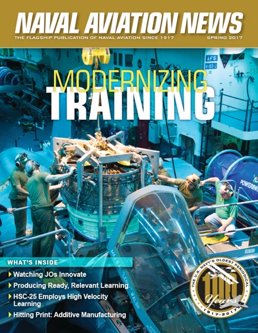
Across the Navy and Marine Corps, aviators, Sailors, Marines, squadrons, instructors and training centers are modernizing training by reassessing and reinventing their approaches. In Flightline, page 4, Capt. Ben Reynolds, commander, Helicopter Sea Combat Wing Pacific, applauds the innovative culture at Helicopter Maritime Strike Weapons School Pacific and encourages leaders to create similar environments. On page 16, the Nimitz Strike Group (CSG) becomes the first CSG to use the fleet warfighting training live, virtual and constructive (LVC) training concept. On page 18, learn how the Naval Air Warfare Center Training Systems Division is supporting CNO’s Sailor 2025 initiative by exploring how and when training is delivered to Sailors. On page 26, Helicopter Sea Combat Squadron (HSC) 25 Sailors apply CNO’s high velocity learning principles to accelerate multi-system qualifications.
>>READ MORE>>

Naval Aviation leaders are becoming more proactive when it comes to improving readiness—ensuring the fleet has the aircraft needed to conduct operational and training missions. On page 17, Brig. Gen. Greg Masiello, assistant commander for Logistics and Industrial Operations, Naval Air Systems Command, discusses the analytical tools developed with stakeholders to predict maintenance issues. Fleet Readiness Center Southwest is expanding its cold spray capability to MV-22 Osprey parts (page 20), and FRC Southeast is integrating the work of Sailors and its civilian artisans, engineers and avionics technicians to become more efficient (page 36). Both Marine Corps and Navy variants of the F-35 Lightning II achieved milestones recently with the F-35B completing at-sea developmental testing (page 22), while Marine Fighter Attack Squadron (VMFA) 121 arrived Jan. 18 in Japan, marking the first deployment of the F-35B outside of the United States (page 25). On page 16, the first F-35C deployed to its first West Coast-based squadron: the recently reactivated “Rough Raiders” of Strike Fighter Squadron (VFA) 125.
>>READ MORE>>
2016
This issue focuses on the future, starting with a detailed account of Naval Aviation’s approach to identifying its next generation of air dominance capability in Flightline, written by Rear Adm. DeWolfe H. Miller III, our new Chief of Naval Operations’ Director, Air Warfare (OPNAV N98). Learn how testing of a 100-percent advanced biofuel, page 17, and 3-D printing of a flight-critical part, page 26, enable future flexibility. The CMV-22B Osprey also demonstrates its flexibility during a Fleet Battle Experiment, page 13.
>>READ MORE>>

This issue celebrates the 100th anniversary of the U.S. Naval Air Force Reserve (NARF), beginning with the cover photo of an EA-18G Growler of the “Star Warriors” of Electronic Attack Squadron (VAQ) 209, photographed after an in-flight refueling between Hawaii and Guam. Read about VAQ-209’s first expeditionary deployment with the EA-18G Growler on page 30. In Flightline, Rear. Adm. W. Michael Crane highlights the adaptive role of the Reserve Component in accomplishing the Naval Aviation mission. In this issue’s main feature, part one of a two-part commemorative series, long-time contributor Cmdr. Peter B. Mersky, USNR (Ret.) chronicles the history of the Naval Air Reserve since its inception in 1916 through the Berlin Crisis of 1962.
>>READ MORE>>

This Spring Issue honors women in Naval Aviation with a feature on the catapult crew aboard CVN 69 on page 22. Superintendent of the Naval Academy Vice Adm. Walter E. Carter Jr. shares his blog on “40-years of women at the Naval Academy” in Flightline on page 4. On page 13, we’ve reprinted Secretary of Defense Ash Carter’s plan to open the last combat positions to women; on page 16, six women naval aviators share their perspective on the military; and on page 24, the Naval Aviation Enterprise recognizes a petty officer for continuous process improvement projects that saved the Navy more than $100,000.
>>READ MORE>>
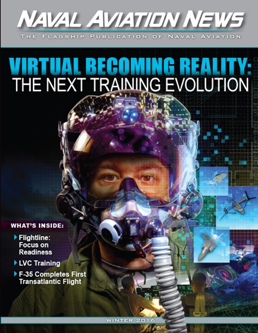
The U.S. Navy is a decade into development of a revolutionary training concept known as Live, Virtual and Constructive (LVC), which blends the environments of live flight and flight simulation while incorporating computerized, constructive units to create modern warfare training scenarios. Recent years have marked significant advancements in LVC, from increased simulation fidelity to the first injection of constructive elements into live aircraft. That progress continues in 2016, with the opening of two major facilities linking various simulators across shared networks, allowing entire air wings to practice tactics in virtual airspace. Those developments and the future of LVC are the focus of this issue. Alongside the main feature on page 16 are sidebars on the first aviation flight simulator and LVC’s role in testing aircraft and their systems.
>>READ MORE>>
2015
The U.S. Navy will induct its first new class of aircraft carrier in more than 40 years this spring with the delivery of pre-commissioning unit Gerald R. Ford (CVN 78), a next-generation flattop, which builds on the previous Nimitz-class carriers with improvements aimed at increasing sortie rates while reducing ownership costs over the warship’s 50-year lifespan. The ship that will usher Naval Aviation into its second century, the Ford is the focus of this issue. Sprinkled within the main feature on page 14 are sidebars detailing the Ford’s testing milestones, training of its Sailors aboard USS George Washington (CVN 73), the 55-year career of a naval catapult engineer, and the keel laying for the second member of the Ford class, John F. Kennedy (CVN 79).
>>READ MORE>>
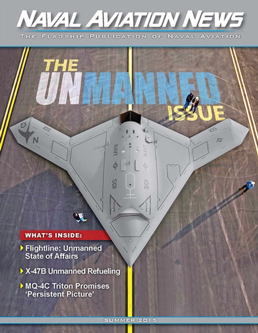
In the span of four days in April, the U.S. Navy marked major testing milestones for two of its future unmanned platforms. The MQ-4C Triton maritime surveillance aircraft began in-flight radar testing at Naval Air Station Patuxent River, Md., April 18, and four days later, the X-47B demonstrator became the first unmanned aircraft to refuel midflight. Both achievements came on the heels of comments made by Secretary of the Navy Ray Mabus on the importance of unmanned systems to the future of naval warfare. Together, these developments drove the theme of this issue. In separate feature articles, we delve into the complexities of the X-47B’s aerial refueling on page 20, and examine how the Triton’s airframe and suite of sensors will combine to bring unprecedented surveillance capability on page 24.
>>READ MORE>>

The U.S. Navy Reserve is celebrating 100 years of history, dating back to March 3, 1915, when the Naval Appropriations Act of 1916 established a United States Naval Reserve. For a century, these service members have answered the call of duty, serving side by side with active-duty counterparts. Today, Reservists are a vital asset and true force multiplier to our Navy. They are prepared, accessible, versatile and willing to go wherever needed. Inside this issue, we highlight the Reserve in two feature articles: How Two Men Impacted the U.S. Navy Reserve (page 14) and a Reserve Squadron Spotlight (page 18) on the VR-62’s Airlifting “Nomads.” Visit http://navyreservecentennial.com to learn more on how Reservists were “ready then,” are “ready now” and will continue to be “ready always.”
>>READ MORE>>
2014
Inside this Issue:
• F-35C Hits a Milestone: Page 10
• The Evolution of the Atlantic Test Ranges: Page 14
• Fleet Readiness Centers Address Hornet Challenges: Page 20
• Reagan Sailor Recognized for Improvement Efforts: Page 24
• Enlisted Ratings Series–Mass Communication Specialist: Page 28
>>READ MORE>>
Inside this Issue:
• War Eagle Take Reins of Poseidon: Page 10
• On Glide Path, On Course: Page 16
• 2013 Year in Review: Page 20
>>READ MORE>>
Inside this Issue:
• Aviation Enlisted Rating Series–Aviation Maintenance Administrationman: Page 10
• VFA-87 Has Guns-a-Blazin’: Page 14
• Taking to the Sky with VMMT-204: Page 16
• Making of a Patuxent River engineer–50’s style: Page 20
>>READ MORE>>